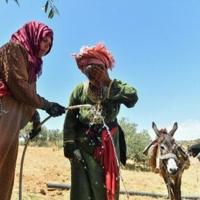In front of a small mosque in central Tunisia, women line up at one of the village’s last water sources, a pipe originally meant for crop irrigation but now a vital resource in the dry area.
“We just need something to drink,” expressed Ribh Saket, 56, under the scorching summer sun as she positioned a jerrycan under a makeshift tap connected to the water supply.
Similar to neighboring Algeria and many parts of the Mediterranean region, Tunisia is currently facing “alert drought conditions”, as per the European Drought Observatory.
However, while drought and increasing temperatures affect the entire region, the impact is especially harsh in rural areas where poverty rates are typically higher.
While almost all of Tunisia’s urban areas receive water from the national water grid, only about half of the rural population has access to it.
The other half mainly relies on wells constructed by local agrarian associations operating under the agriculture ministry.
“We’ve been neglected,” Saket lamented, referring to her village of approximately 250 families that had one such well.
Unfortunately, it was closed in 2018 due to unpaid electricity bills, a common issue among agrarian associations, leaving the villagers without pumps to extract water for their community in the Sbikha area, located about 30 kilometers (18 miles) north of Kairouan city.
Since then, the families have resorted to water from wells originally dug by local farmers for irrigation purposes.
However, none of these wells are authorized by the state as they are often contaminated with pollutants and deemed unsuitable for human consumption due to improper construction and testing.
– ‘Unsustainable’ –
Showing a scar that ran the length of his abdomen, Ali Kammoun, 57, revealed that he had undergone two surgeries due to waterborne diseases.
“Half of us suffer from kidney issues,” his neighbor, Leila Ben Arfa, stated. “The water is contaminated, but we have no choice but to drink it.”
The 52-year-old mentioned that she and other women “carry the jerrycans on our backs”.
Tunisia, currently in its sixth year of drought, ranks as the world’s 33rd most water-stressed country according to the World Resources Institute.
By 2030, the Middle East and North Africa are predicted to fall below the “absolute water scarcity” threshold of 500 cubic meters per person annually, a figure that is already below 450 cubic meters per inhabitant in Tunisia.
Over 650,000 Tunisians, mainly in rural areas, lack running water at home, with almost half of them living far from a public water source, based on a 2023 United Nations report.
Bottled water, costing approximately half a Tunisian dinar (16 cents) per liter, remains a luxury for families residing in Tunisia’s poorest governorate.
“We need to find a solution,” stated Djaouher Kammoun, a 26-year-old farmer who has been sharing his well water with fellow villagers.
“Most families come to fetch water while we’re working, and sometimes we can’t manage both,” he added, describing the current system as unsustainable.
According to the National Agricultural Observatory (ONAGRI), around 60 percent of wells nationwide are privately dug and unauthorized.
While this practice may offer a temporary albeit unhealthy solution for some, it contributes to worsening water scarcity.
A 2022 ONAGRI study revealed that Tunisia’s deep aquifers were being exploited at 150 percent of their recharge rate, with groundwater aquifers at 119 percent.
-‘Many have left’-
“Today, we are stuck in the same cycle, facing the same problems,” Minyara Mejbri, Kairouan coordinator at the Tunisian Forum for Economic and Social Rights (FTDES), commented.
The villagers have protested, blocked roads, and lodged numerous complaints, all without any resolution.
“The authorities claimed we already had access to drinking water,” mentioned Saief Naffati, a 34-year-old leading his community’s efforts to address the crisis.
“They warned us that if we continued to protest, we would face arrest by the National Guard,” he added.
At their breaking point, many residents have opted to leave the village, as mentioned by Naffati.
One such person is his brother, Raouf, who now resides in the coastal city of Hammamet.
Saleh Hamadi, a 55-year-old farmer also grappling with water distribution from his well, stated that “at least 150 families have departed”.
“Most of our young people have moved away, leaving the elders behind,” he expressed.
“In 2024, why is this issue still unresolved? Why are we still thirsty?”
bou/ysm/it/srk/jsa





